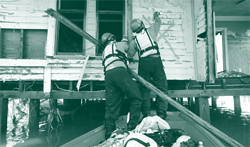November 2008
In this Issue
Resources Mitigate the Impact of Major Disasters
Rising Housing Costs 1985 – 2005: A Closer Look
Housing and Economic Recovery Act of 2008 Boosts Energy-Efficient Mortgages
Riding For Affordable Housing
In the next issue of ResearchWorks
Resources Mitigate the Impact of Major Disasters
After Hurricane Ike made landfall on September 13, 2008, winds of 110 miles an hour and a 13.5-foot storm surge wreaked havoc along the upper Texas and southwest Louisiana coasts. This Category 2 hurricane — a large, slow-moving storm nearly the size of the state of Texas — left Gulf Coast homes destroyed, neighborhoods flooded, infrastructure demolished, millions without power, and thousands unable to return to their homes for weeks or months. Following a presidential declaration that this is officially a major disaster area, the resources that HUD provided to assist Ike's victims as they struggle to return to their normal lives illustrate the kinds of assistance we make available in the aftermath of catastrophe.

In cooperation with state and other federal agencies, HUD offers emergency housing and community development assistance to residents of hurricane-damaged areas. Such assistance is particularly helpful to homeowners and low-income renters who have been forced from their homes. This aid includes foreclosure relief for families, which entails a 90-day moratorium on foreclosures of homes whose mortgages are insured by the Federal Housing Administration (FHA). As part of this moratorium, HUD strongly encourages loan servicers to show other kinds of special forbearance — including loan modifications, refinancing, and waivers of late charges — to these mortgage holders.

Among the resources offered to those living in federal disaster areas are the Section 203(h) and Section 203(k) loan programs, established by Congress under the National Housing Act. These programs make no direct loans, but provide mortgage insurance that protects lenders against the risk of default on loans. Insured loans may be used to finance the purchase or reconstruction of a single-family home that will be the principal residence of the owner. These loans require no downpayment and offer 100 percent financing. HUD's Mortgagee Letter 2006-04 announced revisions to the borrower closing cost guidelines. Per this guidance, mortgagees may charge and collect from mortgagors those customary and reasonable costs necessary to close the mortgage. HUD is presently developing updated guidance regarding closing costs that may be paid by borrowers. Although mortgage limits vary with time, place, and factors like the cost of living, they ensure service to low- and moderate-income individuals. Borrowers pay closing costs and prepaid expenses in cash or through premium pricing. The seller may also pay borrower closing costs and prepaid expenses, subject to a six-percent limitation on seller concessions. An upfront insurance premium (which may be financed) is also collected from the borrower at the time of loan closing.

Provisions of Section 203(k) permit and insure financing for both the purchase and repair of disaster-damaged properties, combined into a single mortgage. Damaged residences are eligible regardless of their age. They need only to have been completed and ready for occupancy, thus waiving the usual one-year minimum residency requirement. The type of mortgage determines the percentage of financing. A 203(k) borrower does not have to have owned a home in order to buy and rehabilitate an abandoned property or a damaged one sold "as is."
In disaster conditions, the underwriting guidelines for both Sections 203(h) and 203(k) are relaxed to allow victims of disasters to have a total fixed payment to gross income ratio of 45 percent, without compensating factors. The 45-percent ratio can also be exceeded with appropriate compensating factors. This provision applies to all FHA-insured mortgages, regardless of the insurance program (Mortgagee Letter 2005-33). A borrower's application must be submitted to an FHA-approved lending institution within one year of the President's declaration.
HUD also provides residents and businesses in affected areas with other types of assistance. Under disaster conditions, state and local officials are authorized to streamline their CDBG and HOME efforts, giving them the flexibility to retarget millions of dollars for housing and other crucial needs without unnecessary delays. Also available is Section 108 assistance, which offers state and local governments federally guaranteed loans to rehabilitate housing, undertake economic development, and repair public infrastructure.
Natural disasters can strike unexpectedly and with severity. Communities wanting to develop plans to ensure their readiness for a disaster like Hurricane Ike can find more information about HUD programs that help disaster victims at www.hud.gov/offices/cpd/communitydevelopment/programs/dri/. A consumer-friendly website that offers guidance for homeowners in declared disaster areas is located at http://portal.hud.gov/portal/page?_pageid=73,1827275&_dad=portal&_schema=PORTAL.
Further information about the Section 203(h) and Section 203(k) loan programs is available at www.hud.gov/offices/hsg/sfh/ins/203h-dft.cfm and www.hud.gov/offices/hsg/sfh/203k/203k—df.cfm, respectively. The Federal Emergency Management Agency (FEMA) lists affected counties and cities, and the corresponding declaration dates, at www.fema.gov/disasters. Nearby FHA-approved lenders can be located at www.hud.gov/ll/code/llslcrit.cfm, or by calling the toll-free FHA Mortgage Hotline, 1.800.483.7342.

